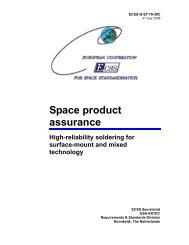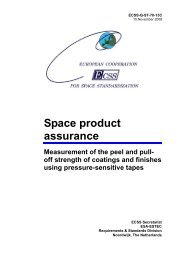ECSS--Q--70--07A
ECSS--Q--70--07A
ECSS--Q--70--07A
You also want an ePaper? Increase the reach of your titles
YUMPU automatically turns print PDFs into web optimized ePapers that Google loves.
<strong>ECSS</strong>--Q--<strong>70</strong>--<strong>07A</strong><br />
<strong>ECSS</strong> 20 January 1998<br />
Annex A (normative)<br />
Process requirements for wave soldering of<br />
printed-circuit boards<br />
1. These requirements are applicable to all operations related to automatic<br />
machine soldering.<br />
2. Except when otherwise specified and approved by the final customer, all<br />
materials and processes utilised in soldering and cleaning operations shall<br />
conform to <strong>ECSS</strong>--Q--<strong>70</strong>--08 and <strong>ECSS</strong>--Q--<strong>70</strong>--10.<br />
3. Non-activated rosin fluxes are preferred, but mildly activated flux is<br />
permitted (See <strong>ECSS</strong>--Q--<strong>70</strong>--08 for approved flux products). All fluxes<br />
shall be adjusted frequently (e.g. specific gravity) to avoid variations from<br />
the optimum. When mildly activated fluxes are used, they should be<br />
changed frequently to ensure a constant and adequate level of activation.<br />
NOTE All fluxes, machine oils and ionisable contaminants on the assembly<br />
shall be removed within one hour of the wave-soldering<br />
operation.<br />
4. The soldering area and machines shall be kept clean and orderly.<br />
Appropriate precautions shall be taken to avoid electrostatic-discharge<br />
problems as defined in <strong>ECSS</strong>--Q--<strong>70</strong>--08. Grounding of the conveyer is to<br />
be envisaged. Toxic or volatile vapours shall be exhausted. Lighting<br />
facilities and component lead preparations shall be as defined in<br />
<strong>ECSS</strong>--Q--<strong>70</strong>--08. Deviations shall require final customer approval before<br />
implementation.<br />
5. Dross (oxides) shall be periodically removed from the solder bath to ensure<br />
that dross does not mix with the liquid solder. Automatic or manual<br />
methods are acceptable, provided that the dross does not come in contact<br />
with the PCB assembly during any portion of the soldering process. Dross<br />
removal materials shall not melt, dissolve or alloy with the liquid solder<br />
and flux.<br />
6. Soldering equipment shall heat the PCB assemblies uniformly and have<br />
the capacity to maintain the temperature during repetitive solder<br />
operations with a maximum variation of +5 °C of the normal soldering<br />
temperature.<br />
27
















